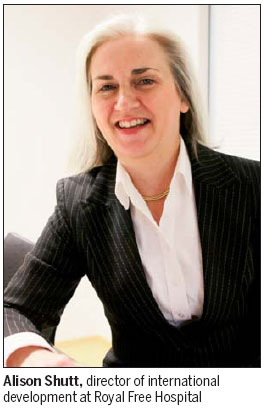Healthcare's Chinese elixir

"The UK hospitals should not 'transplant' into China the Middle East model or the methods of care delivered in the UK. Before entering China, they must have a clear understanding of the way treatment is delivered in China, the payment system and future government developments which may impact on their investment," he says.
|
||||
According to IMS Health Inc, an international healthcare market researcher, China became the world's third-largest pharmaceutical market in 2010. It forecast the Chinese pharma market will grow to 694 billion yuan.
GlaxoSmithKline, the British pharmaceutical company, has invested more than 1 billion yuan in research and development in China over the past 20 years. The company has conducted more than 200 China-based drug development projects in collaboration with Chinese clinical research centers. It has also extended more than 50 types of medicines and vaccines to Chinese patients.
|
|
Last year, it opened a traditional Chinese medicine research unit in China and has made TCM one of the company's R&D programs in China. Zang Jingwu, senior vice-president and head of R&D for GlaxoSmithKline China, said the company's strategy is to integrate existing TCM knowledge of diseases with modern drug discovery technology and clinical trial methodology.
Another China-seeking pharma is London-based AstraZeneca, which opened a manufacturing facility in Wuxi, Jiangsu province, in 2001. The company has since carried out extensive R&D work in China, including a partnership with Peking University on therapies for obesity, diabetes and heart disease.
Last year, the company began building a $200 million (152 million euros) facility in the China Medical City of Taizhou, Jiangsu province. AstraZeneca chose Taizhou because the CMC is a high-technology development zone with strong support from the State Food and Drug Administration and other government agencies.
AstraZeneca is also training general practitioners in partnership with the China Health Promotion Foundation and the Ministry of Health with a goal to improve healthcare in rural areas.
The Chinese central government recently increased spending on public health insurance, particularly for rural residents, with the goal of insuring about 95 percent of its rural population.
"The Chinese government is providing a major investment to improve healthcare in rural communities. We want to be part of this broader market and to build a sustainable business in serving these individuals," says William Charnetski, AstraZeneca vice-president of global government affairs.
Another example is Alliance Boots, an international health and beauty group, that has its headquarters in Switzerland and support offices in the UK. It wants to expand its presence in the Chinese market, both in pharmaceutical wholesaling and retailing.
"We believe by working closely with valued Chinese partners in the future, Alliance Boots has many skills to offer to the Chinese retail pharmacy market to improve both professional and general retailing standards," an Alliance representative says.
Alliance Boots operates in China through joint ventures. Its share of revenue of the joint venture in China (to March 31, 2012) was about $1.3 billion. Its revenues in China were about 3 percent of the group's total revenue for the same period
Last year, Alliance Boots created a joint venture in Guangzhou to employ over 2,700 people. It had previously reached an agreement in 2007 to form a 50-50 joint venture with Guangzhou Pharmaceuticals Corp, one of the largest pharmaceutical wholesalers in China.
Alliance Boots is seeking a minority investor partnership with Nanjing Pharmaceutical Co Ltd. The deal requires regulatory approval.
The UK's technology and telecommunications companies are also hoping to bring their expertise into China to help streamline its healthcare system.
GE Healthcare, the medical arm of General Electric, is promoting its Internet-based medical technologies and solutions in China, such as an Internet-based long-distance imaging technology. The innovation allows doctors to offer real-time assistance and image-based diagnoses to help less experienced local physicians prepare for surgical procedures.
Alicia Greated, director of Research Councils UK in China, says medical research collaboration between the UK and China is also flourishing.
RCUK, a partnership between the UK's seven Research Councils, set up its first overseas office in China in 2007 to fund UK researchers in China. Last year, the Medical Research Council, one of RCUK's member councils, launched a stem cell research project with the National Natural Science Foundation of China. The project has allowed UK and Chinese partners to work together on stem cell research.
Another project RCUK funded is the University of Bradford's Science Bridges China, a 1.3 million pound RCUK program. It is jointly run by the RCUK, China's Ministry of Science and Technology, the Ministry of Education and the NNSF of China.
The program funds many individual efforts, such as a project by the University of Bradford and Tsinghua University to identify key ingredients in complex Chinese medicines in order to isolate ingredients and export them internationally.
"There is enormous growth in China, not just economically, but in terms of research funding and output. If China continues at the presence pace, it will become one of the world's largest producers of scientific knowledge. We want the UK to be a part of this growth." Greated says.
Contact the writers through cecily.liu@chinadaily.com.cn
(China Daily 05/10/2013 page12)
Today's Top News
- Xi stresses improving long-term mechanisms for cyberspace governance
- Experts share ideas on advancing human rights
- Japan PM's remarks on Taiwan send severely wrong signal
- Key steps to boost RMB's intl standing highlighted
- Sustained fight against corruption urged
- Xi calls for promotion of spirit of volunteerism



































